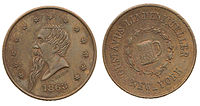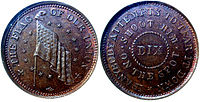- Civil War token
-
Civil War tokens are token coins that were privately minted and distributed in the United States between 1862 and 1864. They were used mainly in the Northeast and Midwest. The widespread use of the tokens was a result of the scarcity of government-issued cents during the Civil War.
Civil War tokens became illegal after the United States Congress passed a law on April 22, 1864 prohibiting the issue of any one or two-cent coins, tokens or devices for use as currency. On June 8, 1864 an additional law was passed that forbade all private coinage.[1]
Civil War tokens are divided into three types—store cards, patriotic tokens, and sutler tokens. All three types were utilized as currency, and are differentiated by their designs. The collectible value of the tokens is determined chiefly by their rarity.
Contents
History
By 1862, the second year of the Civil War, government-issued coinage began vanishing from circulation. American citizens hoarded all coins with gold and silver, and eventually began hoarding copper-nickel cents as well. This made it extremely difficult for businesses to conduct transactions. In response, many merchants turned to private minters to fill the void left by the hoarded coins. The first of these privately minted tokens appeared in the autumn of 1862, by H. A. Ratterman, in Cincinnati, Ohio. It is estimated that by 1864, there were 25,000,000 Civil War tokens (nearly all redeemable for one cent) in circulation, consisting of approximately 7,000–8,000 varieties.[2]
One of the best-known and commonly struck types were store cards known as "Lindenmueller tokens," named for New York barkeep Gustavus Lindenmueller. In 1863, Lindenmueller had more than one million of his one-cent tokens struck and placed into circulation. One of the common uses for the token was for streetcar fare. The Third Avenue Railroad company of New York, which had willingly accepted a large quantity of the Lindenmueller tokens in lieu of actual currency, asked Lindenmueller to redeem them. He refused, and the railroad had no legal recourse. Incidents such as these eventually forced the government to intervene.[3]
On April 22, 1864, Congress enacted the Coinage Act of 1864. While the act is most remembered for the introduction of the phrase "In God We Trust" on the newly created two-cent piece, it also effectively ended the usage of Civil War tokens. In addition to authorizing the minting of the two-cent piece, the act changed the composition of the one-cent piece from a copper-nickel alloy (weighing 4.67 grams) to a lighter, less thick piece composed of 95% copper (weighing 3.11 grams).[4] The new one-cent piece was much closer in weight to the Civil War tokens, and found greater acceptance among the public.[5]
While the Coinage Act made Civil War tokens impractical, the issue of their legality was decided on June 8, 1864, when Congress enacted 18 U.S.C. § 486, which made the minting and usage of non-government issued coins punishable by a fine of up to $2,000, a prison term of up to five years, or both. (Chapter 25 of Title 18 deals specifically with counterfeit and forgery). It did not make it illegal to own Civil War tokens, however, and evidence exists that the tokens were viewed as collectibles as early as 1863, when the first known listings of Civil War tokens were published.[2]
Types
Patriotic tokens
Patriotic Civil War tokens typically displayed a patriotic slogan or image on one or both sides. Since the majority of these tokens were minted in Union states, the slogans and images were decidedly pro-Union. Some common examples of slogans found on patriotic tokens are "The Union Must and Shall Be Preserved," "Union For Ever," and "Old Glory". Some of the images found on patriotic tokens were the flag of the United States, a 19th-century cannon, and the USS Monitor.[6]
Among the best-known varieties of patriotic tokens are the so-called "Dix tokens." They are named for John Adams Dix, who served as Secretary of the Treasury in 1861. In a letter from Dix to a revenue cutter captain, Lieutenant Caldwell, he orders Caldwell to relieve another cutter captain of his command for refusing an order to transfer from New Orleans to New York. The letter ends with the following sentence: "If any one attempts to haul down the American flag, shoot him on the spot." The quote found its way to a number of patriotic tokens, albeit with a slightly modified wording ("haul down" is usually replaced by "tear it down").
Store cards
Civil War store cards differ from patriotic tokens in that one or both sides displays the name and/or location of a privately owned business. Businesses that could afford it had two custom dies made, with both advertising the business. Otherwise, only one side displayed the business's information.[7]
Sutler tokens
Sutler tokens are similar to store cards. Rather than listing the name of a private business, however, these tokens bore the name of a particular army unit (usually a regiment) and the name of the sutler who conducted transactions with the regiment. Of the three types of Civil War tokens, sutler tokens are by far the rarest.
Collectible value
There are several factors that determine the collectible value of Civil War tokens. The main factor is rarity, which is measured on a scale from 1 to 10 (1 being the most common type). The scale was developed by noted numismatic dealer and writer George Fuld.
The material used to mint Civil War tokens can also affect collectibility. Civil war tokens were minted using a variety of materials, copper being a common choice (often actually bronze). Other materials used for minting were nickel, tin, German silver, white metal, and silver. Examples of tokens minted using rubber are also known to exist.[2][8]
Fuld rarity scale
- R-1: Greater than 5,000
- R-2: Between 2,000 and 5,000
- R-3: Between 500 and 2,000
- R-4: Between 200 and 500
- R-5: Between 75 and 200
- R-6: Between 20 and 75
- R-7: Between 10 and 20
- R-8: Between 5 and 10
- R-9: Between 2 and 4
- R-10: Unique (one known example)
Notes and references
- ^ Yeoman, R.S., A Guide Book of United States Coins (2004 edition), Whitman Publishing, 2003. ISBN 1-58238-199-2
- ^ a b c George and Melvin Fuld, U.S. Civil War Store Cards, Quarterman Publishing, Inc., 1975. ISBN 0-88000-135-6
- ^ Tebben, Gerald. "An overview of Civil War Tokens", Columbus, O., Civil War Tokens. Retrieved June 26, 2006. Archived June 27, 2006 at the Wayback Machine
- ^ "Indian Head Cents". CoinFacts.com. Retrieved on June 23, 2006
- ^ "Indian Head Bronze Cents 1864-1909". www.coinresource.com. Retrieved on June 23, 2006.
- ^ Farr, Arthur W. March 1999. "More on the Monitor and Merrimac" Civil War Token Society. Retrieved July 1, 2006
- ^ Civil War Patriotic Tokens. civilwartokens.com. Retrieved June 22, 2006.
- ^ Civil War Tokens. civilwartokens.com. Retrieved June 23, 2006.
External links
Categories:- Tokens
- Historical currencies of the United States
- Economic history of the American Civil War
Wikimedia Foundation. 2010.



